

Simcoe County Oct 21 2016 Handout.pdf. EDUC 512 Week 5 APU EdTech. The Machine is Us/ing Us Depth of Knowledge Check out Hess’ Cognitive Rigor Matrix, which correlates Depth of Knowledge with Bloom’s Taxonomy.

Bloom’s Revised and Depth of Knowledge working together… Activity: Collaborative Web 2.0 Google Presentation This activity on Webb’s Depth of Knowledge and Web 2.0 tools will have us all working as a group to create a Google Presentation. We will create a Google Presentation highlighting Web 2.0 tools as they correlate to Webb’s Depth of Knowledge. The Google Presentation has already been created. Part One: Each student must create AT LEAST two slides that showcases a Web 2.0 tool and the corresponding level and description of Webb’s Depth of Knowledge (other than Facebook, Twitter, or YouTube) that can be used to support the curriculum. Empowering Student Relationships With Media. Debates over children and media use are nothing new, but the technologies by which children primarily interact with media have changed significantly.

Most guidelines related to "screen time" were developed when television was the dominant media, but new technologies are making us question the value of older research. In its most recent report on the subject, the American Academy of Pediatrics makes reference to "important positive and prosocial effects of media use," and a call for expanding media education programs in schools. While more dedicated media education in schools would be great, it is little more than a pipe dream in the current climate of low budgets and high-stake tests. It is therefore incumbent on individual educators to help students interact with media in ways that are critical and empowering. We cannot limit this work to media that we have selected for quality or educational value. A New Taxonomy Image Credit: Josh Weisgrau Consume Curate Create Critique Publish.
A Must Have Chart Featuring Critical Thinking Skills. Critical thinking is an essential skill in our life.It is through thinking critically that we get to sideline our biases(cultural, racial,ethnic...etc) and see the clear picture.Critical thinking is a sort of meta-thinking, that is thinking about thinking.
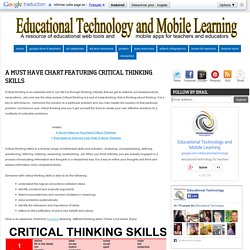
It is a key to self-reliance : memorize the solution to a particular problem and you may master the solution to that particular problem, but improve your critical thinking and you ll get yourself the tools to create your own effective solutions to a multitude of unfamiliar problems. related : Research in Critical Thinking. The Center conducts advanced research and disseminates information on critical thinking.
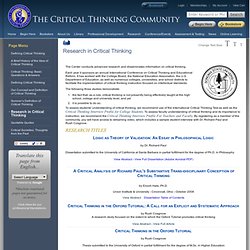
Each year it sponsors an annual International Conference on Critical Thinking and Educational Reform. It has worked with the College Board, the National Education Association, the U.S. Department of Education, as well as numerous colleges, universities, and school districts to facilitate the implementation of critical thinking instruction focused on intellectual standards. The following three studies demonstrate: Critical Thinking. 6 Ways to Honor the Learning Process in Your Classroom. Roughly put, learning is really just a growth in awareness.
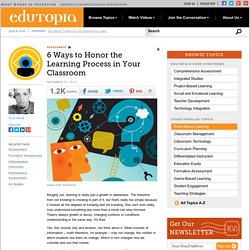
The transition from not knowing to knowing is part of it, but that's really too simple because it misses all the degrees of knowing and not knowing. One can't ever really, truly understand something any more than a shrub can stay trimmed. There's always growth or decay, changing contexts or conditions. A Quick Guide to 21st Century Critical Thinking Skills for Educators. A Taxonomy Tree: A Bloom's Revised Taxonomy Graphic. A Taxonomy Tree: A Bloom’s Revised Taxonomy Graphic by TeachThought Staff If you’re a TeachThought reader, you know that thought is at the core of our content–curiosity, critical thinking, self-direction, and play among other slivers of learning.
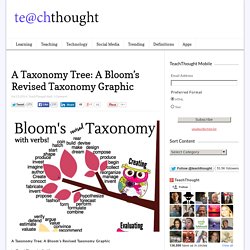
This is especially true as it relates to teaching, learning, and technology. At the point where teaching, learning, and thinking overlap sits the concept of a learning taxonomy.
Using “Frameworks” to Enhance Teaching and Learning. September 17, 2012 By: Patrice W.
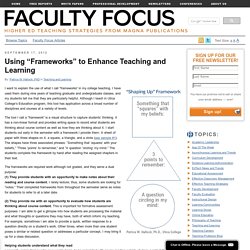
Hallock, PhD in Teaching and Learning I want to explain the use of what I call “frameworks” in my college teaching. I have used them during nine years of teaching graduate and undergraduate classes, and my students tell me that they are particularly helpful. Although I teach in Utica College’s Education program, this tool has application across a broad number of disciplines and courses at a variety of levels. The tool I call a “framework” is a visual structure to capture students’ thinking. The frameworks are required work although not graded, and they serve a dual purpose:(1) They provide students with an opportunity to make notes about their reading and course content.
MAKE STEAM: Giving Maker Education Some Context. As an experiential educator who has fully embraced technology as a means for allowing and facilitating learner voice, creativity, innovation, inventiveness, the Maker Education movement fits into my vision about what a good education entails.

I have been blogging and presenting about Maker Education – see But recent discussions with other educators and administrators made me realize that the idea of maker education is often vague and seems unrealistic in terms of regular classroom instruction. As such, in the future, I am going to associate and discuss Maker Education in the context S.T.E.A.M. – science, technology, engineering, arts (including language arts), math, hopefully, encouraging regular classroom teachers to integrate maker education projects into their classrooms. What follows are some resources and articles I compiled to provide educators as part of this discussion. Link to Thinglink that contains links to the following resources – Like this: Like Loading...